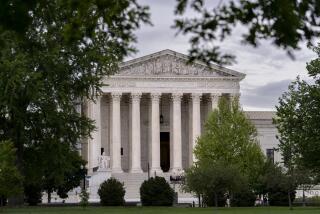Fired White Teacher’s Case Gets Support From Clinton
- Share via
WASHINGTON — The Clinton administration on Friday urged the Supreme Court to uphold a ruling awarding damages to a white New Jersey teacher laid off by a school board that sought to promote racial diversity by keeping an equally qualified black instructor.
But Acting Solicitor General Walter Dellinger, in a brief filed with the court, implored the justices to interpret the case narrowly and not use it as a vehicle to broadly restrict affirmative action-related employment decisions.
Dellinger said there are circumstances--not presented by the New Jersey case--where employers should be able to take race into account for reasons other than simply remedying past discrimination.
These would include a law enforcement agency assigning an undercover officer of the same race to infiltrate a racially homogenous gang, or taking action to achieve a racially diverse police force to win public support needed to prevent and solve crime against a backdrop of racial unrest, Dellinger said.
But in the case of the white Piscataway, N.J., business education teacher, Dellinger asked that the justices affirm the U.S. 3rd Circuit Court of Appeals’ ruling in her favor solely on the ground that the layoff “unnecessarily trammeled” her interests.
The 3rd Circuit erred by going further and holding that Title VII of the 1964 Civil Rights Act bars “all non-remedial, race-conscious employment decisions,” Dellinger said.
The Justice Department’s argument in the New Jersey case seems to have no direct effect on its opposition to the ban California voters approved on affirmative action programs for women and minorities. That measure, Proposition 209, has been ruled constitutional by the U.S. 9th Circuit Court of Appeals, a decision expected to be appealed to the U.S. Supreme Court.
The administration filed a friend-of-the-court brief supporting the challenge to Proposition 209, which President Clinton also has opposed as an overreaction to possible flaws in affirmative action programs.
In the New Jersey case, the Justice Department argument was the latest twist in what has proved to be a difficult political problem.
Charles Ruff, counsel to the president, said in a statement: “The president has made it clear that he wants to ‘mend, not end’ affirmative action. This administration continues to support the non-remedial use of affirmative action where it is narrowly tailored to achieve a compelling purpose.
“We believe that the court of appeals was wrong in holding that all non-remedial, race-conscious employment decisions are prohibited. We do not believe, however, that the Supreme Court needs to reach that question because the case can be decided on narrower grounds--that is, the absence of an adequate justification for the school board’s layoff decision.”
The White House had previously urged the high court not to take up the case, which would have left the lower court’s ruling the law in that district but prevented the ruling from being adopted as the nationwide standard.
White House spokesman Barry Toiv told reporters on Martha’s Vineyard, Mass., where Clinton is vacationing: “Our previous filing in the case suggested that this was not an appropriate case for the Supreme Court to take, and what we are saying today is that this is a case that should be decided on narrow grounds and should not be used in the way that the appeals court used it.”
The case began in 1989 when the Piscataway Township school board was faced with the need to lay off one of its two business teachers. Both started work the same day and therefore were deemed equally qualified. Race was their only obvious difference.
The board decided to retain the black teacher and dismiss the white teacher. The school system was not attempting to compensate for past discrimination, and its staff at the time reflected the racial makeup of the community. Nonetheless, the board’s vice president said that retaining the black teacher “was sending a very clear message that we feel that our staff should be culturally diverse. . . .”
Sharon Taxman, the white teacher, sued under the terms of the Civil Rights Act of 1964, which makes it illegal for an employer to “refuse to hire or discharge” any person “because of such individual’s race, color, religion, sex or national origin.”
What makes the case unusual is the board’s acknowledgment that race was the deciding factor between two equally qualified employees.
U.S. District Judge Maryanne Trump Barry in Newark, N.J., ruled that the white teacher was a victim of race discrimination and awarded her $144,015 in damages.
The Bush administration initially opposed the school board. In 1994, the Clinton administration switched the federal government’s position, siding with the school board. But it was rebuffed by the 3rd Circuit Court in Philadelphia, which in an 8-4 opinion said the “clear antidiscrimination mandate” of the 1964 law protects whites as well as blacks.
An “affirmative action plan, even one with a laudable purpose, cannot pass muster,” the circuit court said, unless an employer is making up for past discrimination or a clear “underrepresentation” of minorities on its staff.
In arguing that the school board action should be voided on narrow grounds, Dellinger said the board “has failed to satisfy the heavy burden of justification applicable to the use of race in layoff decisions.”
The Supreme Court will hear arguments in the case in its term that opens in October. It is expected to issue a ruling next year.
Times staff writer Art Pine contributed to this story from Edgartown, Mass.
More to Read
Get the L.A. Times Politics newsletter
Deeply reported insights into legislation, politics and policy from Sacramento, Washington and beyond. In your inbox twice per week.
You may occasionally receive promotional content from the Los Angeles Times.










